Jobs overview
Jobs are scheduled tasks to run project flows at the set frequency, which can be daily, weekly, or at recurring intervals using cron schedule expression. You can schedule jobs for different scenarios in a project and run the project flow at the set time. If there are no scenarios in a project, you can select the default scenario to run the flow. You can also configure parameters to this job to store new models and output datasets generated after running the project flow every time at the set time interval. Whenever the job is triggered, the project flow is executed to generate the latest output dataset. This dataset gets stored on the platform. However, you can save this dataset to an external data source by configuring the data source to which you want to publish this file while creating a job.
Scheduling a job
Use this procedure to schedule a job for a scenario within a project.
From the left navigation menu, select Projects. The Projects dashboard is displayed.
Select the project for which you want to schedule or create a job. You can create jobs for different scenarios in a project.
The Canvas page is displayed
Click the Jobs tab on the project navigation menu on the left to open the jobs page.

Do one of the following:
Click the plus icon
on the top right-corner of the page.
Click the +New Job option on the workspace to create a job. However, you can only view this option when there are no jobs created in this project.
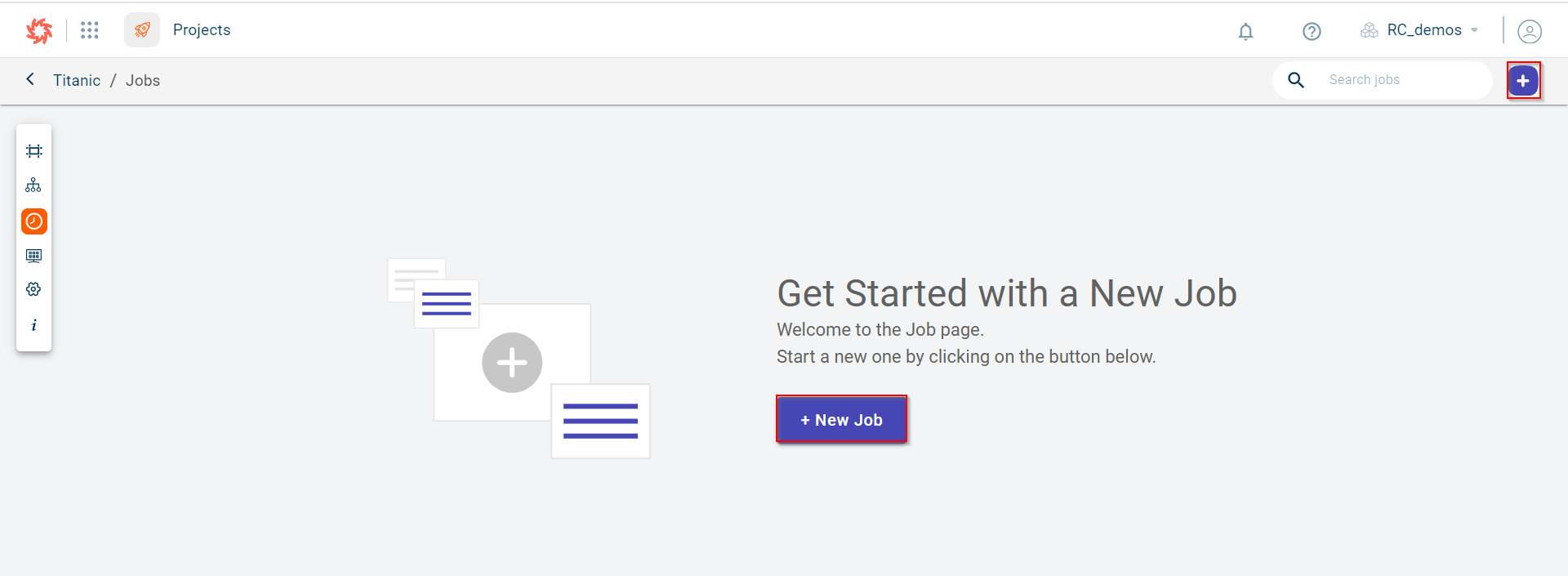
The following page is displayed where you can schedule the job to run this datapipeline at the set time interval.
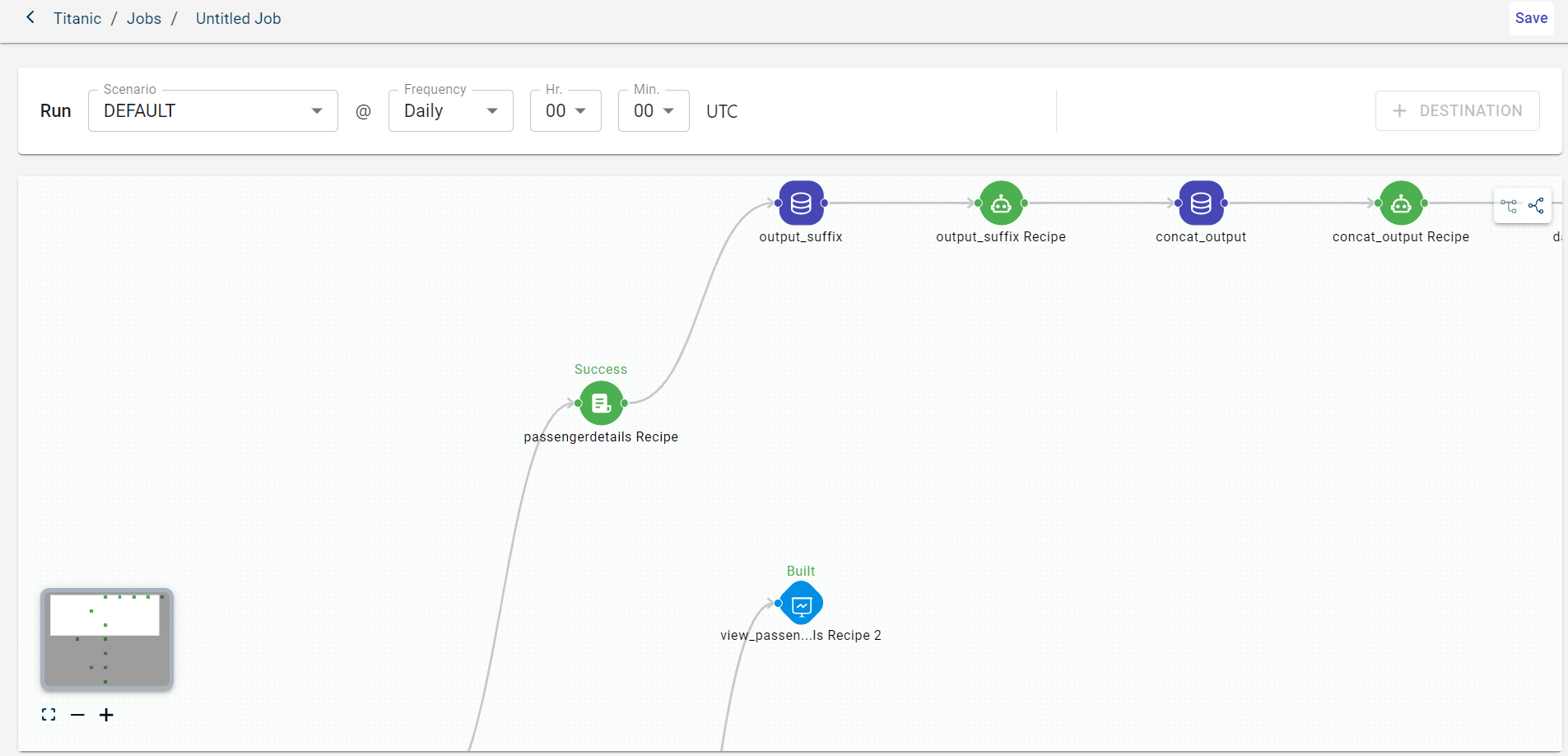
Click the default job name to provide a custom name on the top.

Select the scenario on which you want to run the project flow at the scheduled frequency.
Select the job frequency. Possible values:
Daily - This displays Hrs and Min. drop-down to select the time at which the job should be triggered.
Weekly - This displays days in a week and time at which the job should be run.
Cron - This displays the unix-corn format to schedule the job.
View the project canvas.
Click Save to create the job. This also enables the +DESTINATION option to configure the data connector to which you can publish the generated output datasets or the input dataset.
You can see the global variables button only if those are defined at the project level. After creating the job, you can change the value in global variables.
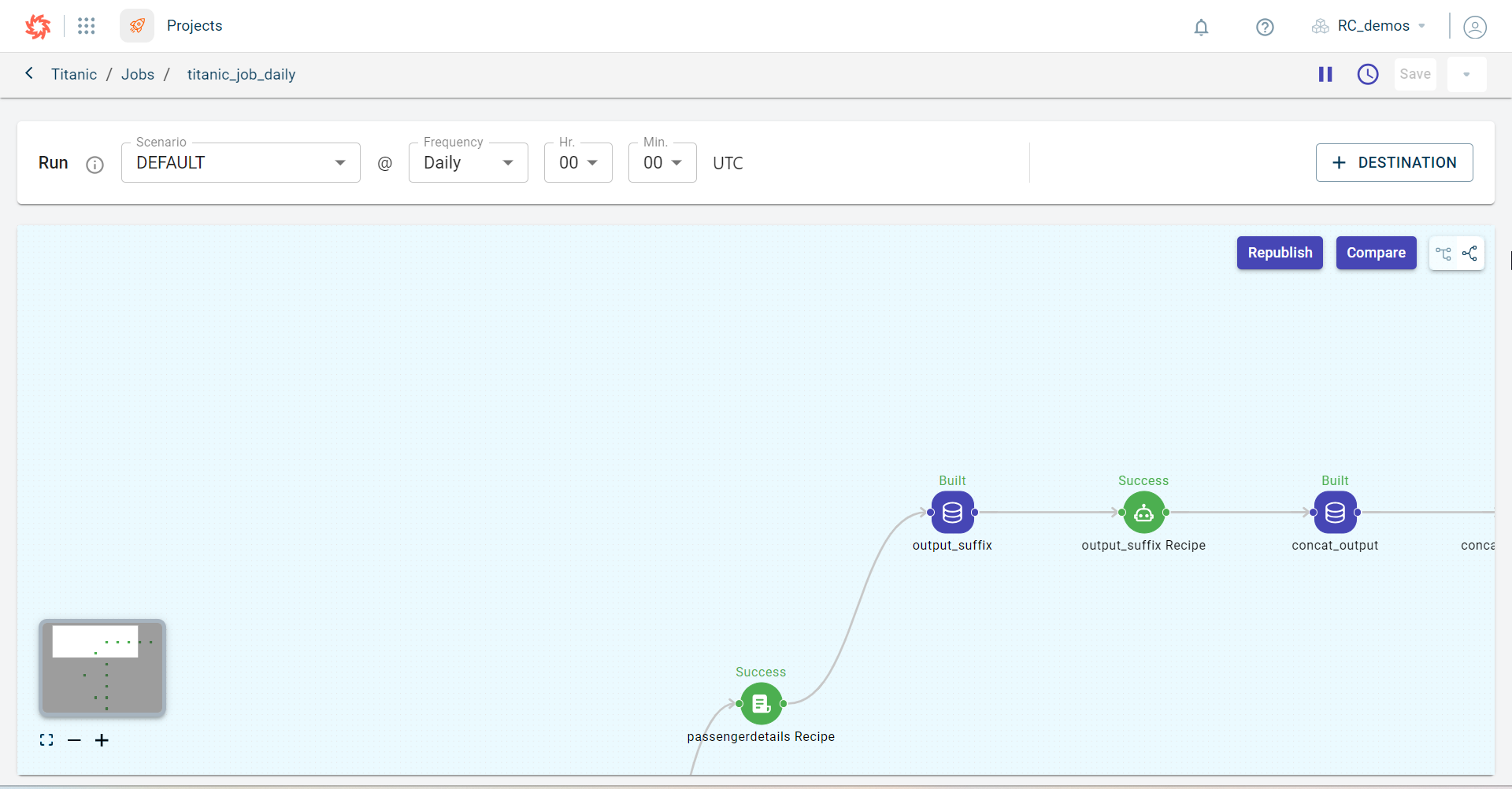
Click + DESTINATION. This opens the Destinations side panel.
Note
This button is enabled only if you have configured external datasources in your tenant.

Click + DESTINATION.
Select the dataset that you want to add to the destination. If the dataset list is huge, you can use the search option to search for the dataset you want.
Select the destination from the drop-down list. You can only view the list of external datasources configured under this tenant excluding Snowflake and Fivetran connectors.
When you select the SQL connector to synchronize or copy the output dataset generated after running the project, the table name column is displayed. Here, you can provide the table name and select either “Append” or “Replace”. Opting for the “Append” option will append the dataset to the existing one, provided both datasets share the same schema. Alternatively, selecting the “Replace” option will replace the existing dataset with the new one.
If you choose the data connector as MongoDB, you can provide the database name and collection. In the event that the provided collection name already exists, the new dataset will be appended to the existing collection.
Provide the destination folder and destination file name to save the file in the destination folder with the new file name after the job is run every time at the scheduled time.
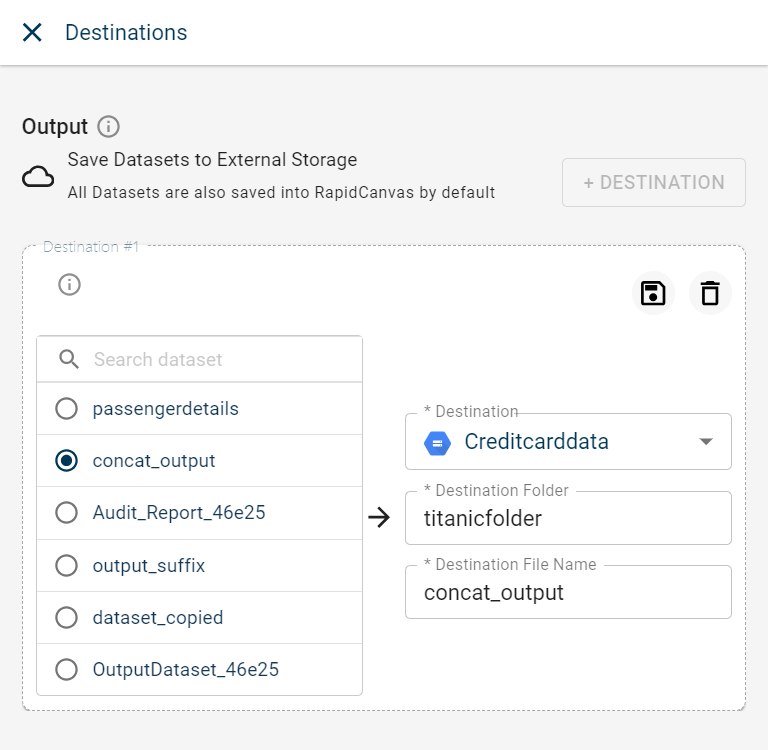
Select the To create new file for every run check box to create a new file after every job run. The new file will be saved with the RUN ID. Clearing this check box overrides the existing file.
Click Save to save this destination. This button is enabled only after you select all the required destination fields.
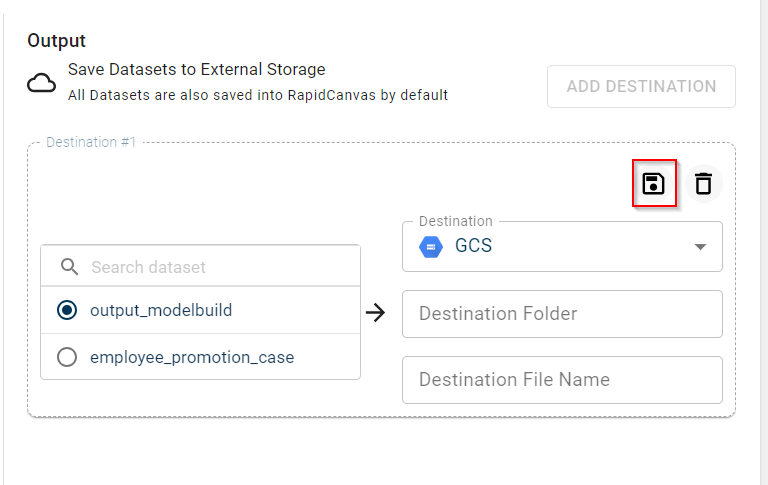
Note
You can store files in multiple destinations. To add another destination, click + DESTINATION. If you want to remove any destination, click the delete icon.
If you no longer want to save the output to the configured destination, you can use the delete icon to delete the destination.
Close the window after configuring the destination for the job.
Click GLOBAL VARIABLES to change the configured parameters for this job.
Note: The GLOBAL VARIABLES button is enabled only when the global variables are declared at the project level. To configure global variables, refer configuring global variables at a project level.
Change the value for the key. Please note that you cannot change the key.
Running the job manually
Use this procedure to run and re-run the job manually. However, the job run is performed automatically on the recurring schedule.
To run a specific job:
Select the project to run the job.
Click the Jobs tab to open the list of jobs created in this project. You can only see the jobs list page if the jobs are created for this project.
Select the job name link that you want to run manually. This takes you to this specific jobs page

Click Run to run the job manually. This opens the Manual Run Configuration side panel.
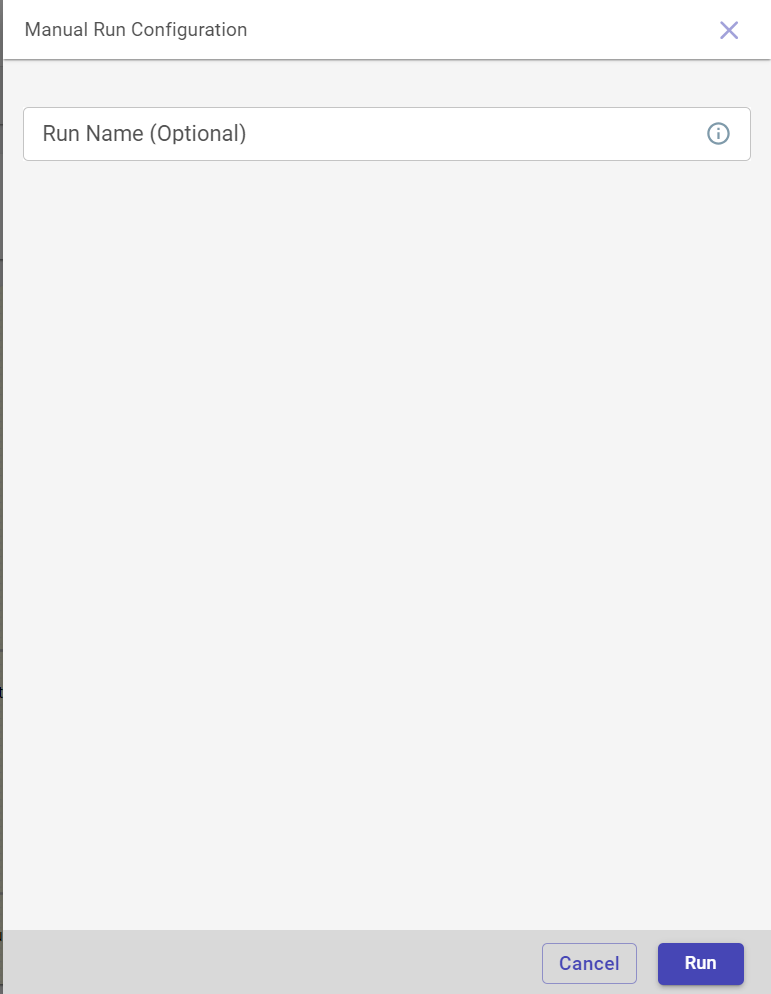
Provide the run name and click RUN.
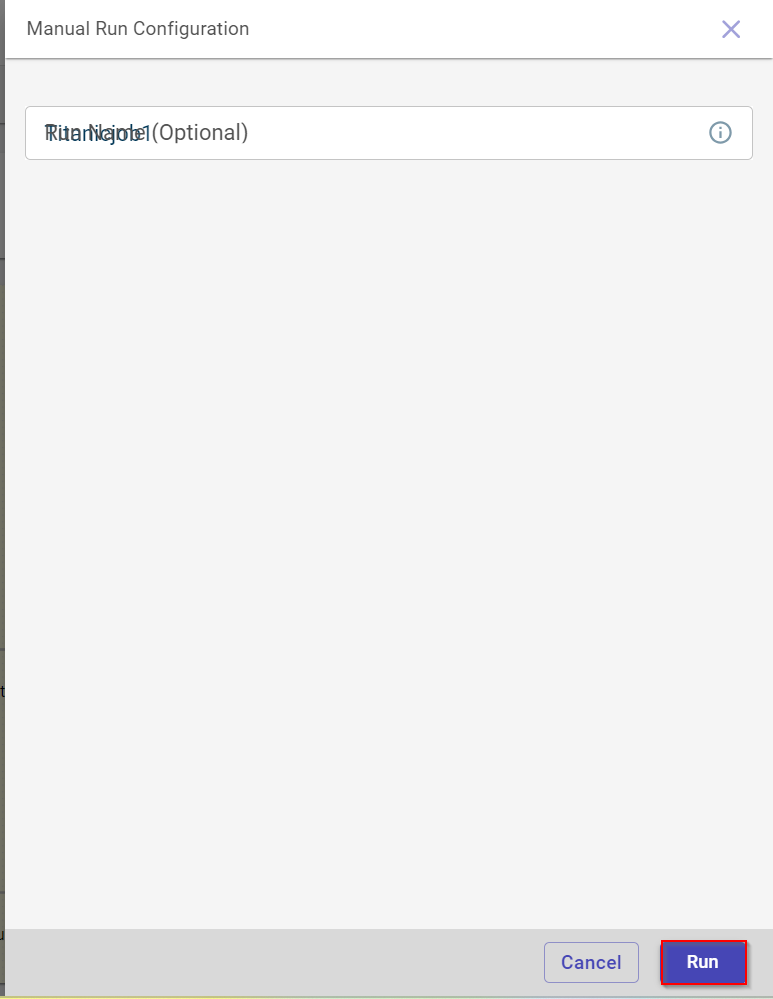
When the job run is in progress, the status changes from Created changes to Entity Loading and then to Running. Once the job is run successfully, you can view the output in the Job Run History page.
Click the ellipses icon that appears in the Run Name column on the Job History page and select RE-RUN to re-run the job.
Managing scheduled jobs in a project
Use this procedure to manage all the jobs scheduled in a project.
Click the menu on the dashboard and select Projects. The Projects dashboard is displayed.
Select the project for which you can to schedule or create a job. You can create jobs for different scenarios in a project.
Click the Jobs tab on the left navigation menu of the project to open the jobs page and view the list of jobs you have already created.

Note
If there are multiple jobs, you can use the search option to find the job you want.
You can also create a new job, using the + Job option. To create a job, see Creating a job.
Click on the Job name that you want to edit. This redirects you to the Jobs page where you can edit the job details.
Modify the required details.
Click Save to view the new changes.
On this Jobs page, you can also:
Run this job manually, clicking the Run button.
View the run history, using the Run history icon
 . This allows you to view the history of all jobs run till date and up to 300 records of last 30 days.
. This allows you to view the history of all jobs run till date and up to 300 records of last 30 days.
Pause the job that is running, using the Pause icon
. You can click the same icon to start the paused job.
Click the Action drop-down to select the Delete option to delete this job permanently.
Click the Timeout 1hr option to change the time out duration of the job. You can view this option when you click the Actions drop-down. By default, the time out duration is set to 1 hr. Setting this will terminate the job after this duration.
Viewing the scheduled jobs in a project
Use this procedure to view all the jobs in a project and see the output generated after every job run.
From the menu on the dashboard, select Projects. The Projects dashboard is displayed.
Select the project for which you can to schedule or create a job. You can create jobs for different scenarios in a project.
Click the Jobs tab on the left navigation menu of the project to open the jobs page and view the list of jobs you have already created.

Review this information:
- Job Name:
The name of the job.
- Status:
The status of this scheduled job. Possible values:
Scheduler Active - By default is set to Active.
Scheduler Inactive - Indicates that the manual job run has been paused.
- Last run by:
Indicates whether the business user or scheduler has run the job last.
- Last Run:
The date and time at which the job was run lastly.
- Last 5 Runs:
Indicates the last five job run status. Possible values:
Failed - The job has failed to run.
Success - The job has been run successfully.
Created - The job has been created.
- Last Run Output:
Click to view the output generated after running the job. You can only view the output after the job is run and until then this option remains disabled.
- Last Run Log:
Click to view the logs. You can check the logs to understand the errors in jobs that have failed to run.
- Last Run Canvas:
Click to view the canvas page. You can only view the page to see the failed blocks and successful blocks in the data pipeline.
- Last Run Global Variables:
Click to view the last run global variables in this job.
- Updated on:
The date and time when the job was last updated.
- Updated by:
The user who last modified the job details.
You can click on the table settings icon to reorder the columns and select and deselect the columns you want to view.
Viewing the run history of a specific job
Use this procedure to view the run history of a particular job in the project.
Select the project and click Jobs to view the list of jobs created within this project.
Do one of the following to access the job run history page
Click the job name under Job Name column in the table to navigate to the respective Job page and click the Run History icon.


Click the ellipses icon in the Job Name column and select the RUN HISTORY option to view the list of completed job runs for the selected job.

The Run History page appears.

Review the following details displayed for every job run:
- Run Name:
The name of the job run.
- Triggered by:
The user or scheduler that triggered this job.
- Started at:
The time at which the job has started to run.
- Runtime:
The duration of the job run.
- Status:
The status of the job run. Possible status:
Success - Indicates that the job run is successful.
Started - Indicates that the job run is in progress.
Failed - Indicates that the job has failed to run.
Timed out - Indicates the job has been timed out.
Recipe Timed out - Indicates that the recipe within the job has been timed out.
Created - Indicates the job has been created.
Recipe Running - Indicates that the recipe within the flow has started to run.
Entity loading - Indicates that the data is loaded for entities with external data source
- Output:
The output generated after running the job. Click to view and download the input dataset on which the model was created and generated output datasets. You can also view the generated artifacts and models but cannot download them.
- Log:
The log of this particular job run. Click to view the logs to debug the issues in the job run.
- Canvas:
The canvas generated after running the job. Click to view the canvas on which the run job was performed.
- Global variables:
The global variables used in this job run. Click to view the global variables linked to this job run.
Publishing the updated data pipeline to selected jobs from canvas
Use this procedure to republish the data pipeline to jobs. When you update the dataset, delete a recipe or add a new recipe to the data pipeline, you can republish the new flow to jobs using the republish option on the canvas. This updates the canvas on the selected jobs.
To publish the changes made in the data pipeline to all or specific job(s) in a project:
Select the project to navigate to the canvas view page.
Click the Actions drop-down and select Publish to Jobs.

This displays the list of jobs to which you want to publish the latest or updated data pipeline.
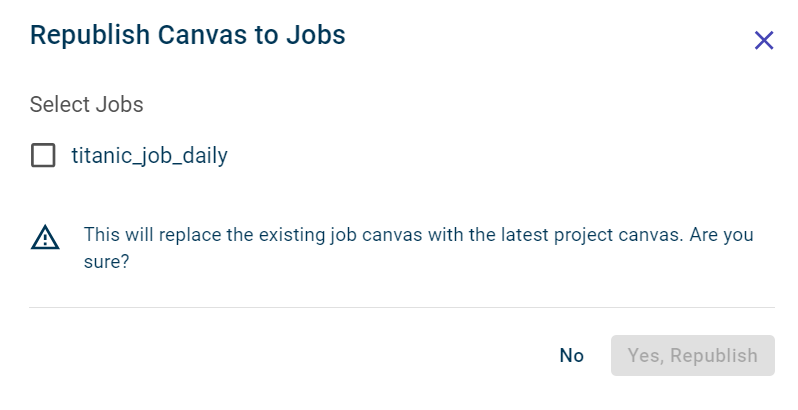
Select the check boxes corresponding to the jobs to which you want to update the latest canvas. This enables the Yes, Republish button.
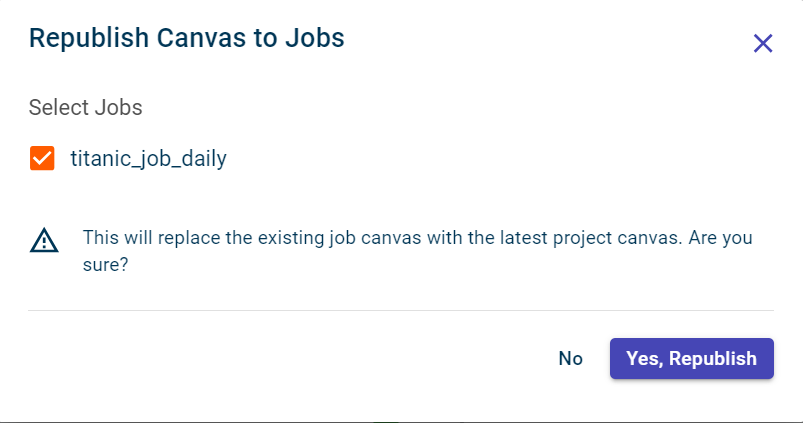
Click Yes, Republish to republish or update the latest data pipeline to the selected jobs.
You can now navigate to the respective job page to see the latest data pipeline. From the next schedule, the job run is performed on the new modeling pipeline.
Fetching the latest data pipeline from jobs
Use this procedure to fetch the changes made to the data pipeline on the canvas to the data pipeline in a specific job.
To publish the changes made to the data pipeline on the canvas to a specific job from jobs page:
Select the project to navigate to the canvas view page.
Select Jobs from the project level navigation. This takes you to the Jobs page where you can view the list of jobs created for this project.
Select the job to which you want to publish the changes made to the data pipeline. This takes you to the selected job page.
Click the Republish button in the canvas section to incorporate all the changes that were made to the canvas at the project level to this pipeline.
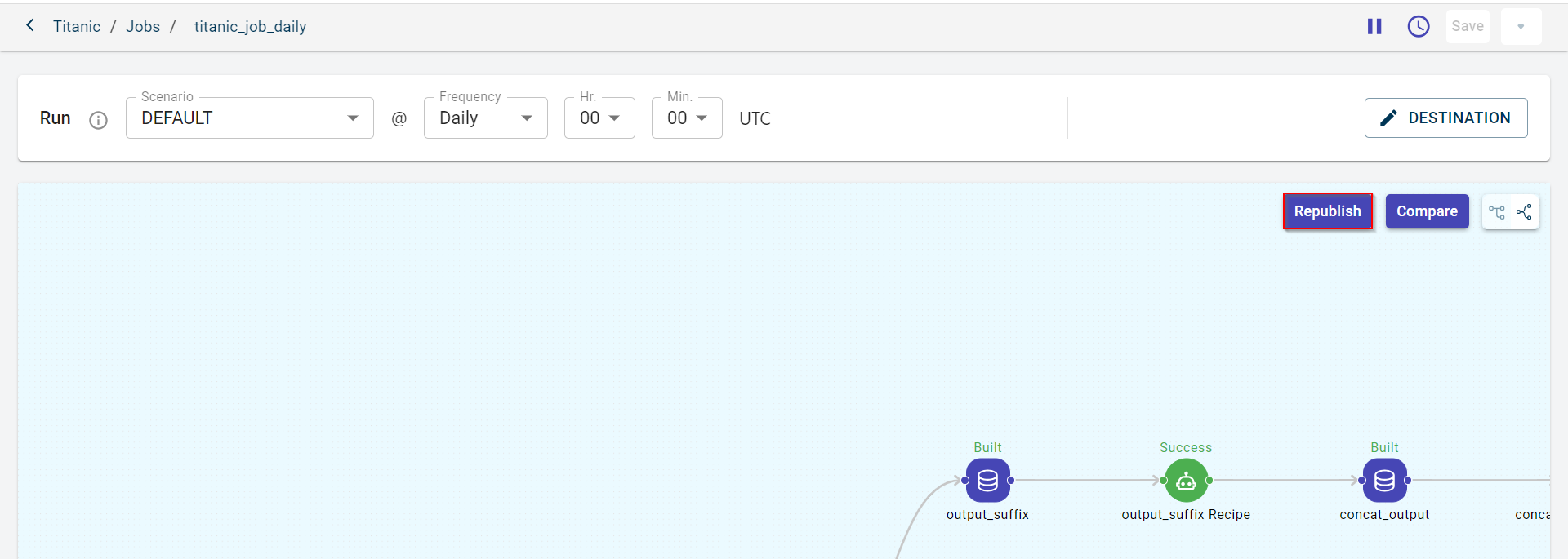
The Republish Canvas to Job window appears.
Click Yes, Republish to republish the project canvas to the job.
Comparing the canvas of the job with current canvas of the project
Use this procedure to compare current canvas of the project and canvas of the job side-by-side to track changes.
To compare the canvas of the job with the current canvas of the project:
1.Select the project to navigate to the canvas view page.
Select Jobs from the project level navigation. This takes you to the Jobs page where you can view the list of jobs created for this project.
Select the job that you want to compare with the current canvas of the project. This opens the Job page.

Click Compare to compare the canvas of this job with the canvas of the project to notice the differences. You can see the difference between both the canvases side by side.

If you notice the canvas of the job is not up-to-date, you can click Republish to fetch the latest canvas of the project to update the changes.